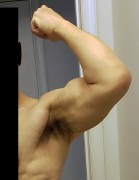|
PT update: I'm no longer so laterally shifted that my chin lined up outside my right hip. I'm now up to a stretching routine every 2 hours, and the elliptical for up to 10 minutes at time on low resistance. However I'm still a week away from being allowed to sit on the couch. Being injured sucks balls
|
|
|
|

|
| # ? Jun 7, 2024 09:28 |
|
ch3cooh posted:PT update: I feel ya' brother.  I've decided to start back in February. It will be my three years sober (from booze) anniversary and a good way to celebrate. P. S. to the thread on BlackBeltChat - I used to coach a fencing club in college so when the Walking Dead style apocalypse comes call me.
|
|
|
|
As someone who enjoys half guard and the kimura I thought this video was pretty cool https://www.youtube.com/watch?v=mLLQBxG1ojo
|
|
|
|
Captain Log posted:It will be my three years sober (from booze) anniversary Hey cool! Four here, not coincidentally also how long I've been doing BJJ.
|
|
|
|
Here's a few questions for you guys to ponder. These relate to the principles of grappling and the conceptual framework rather than any specific move. Many of these are asked and answered within John's social media posting but I would ask you to ponder these independently. First, what distinguishes BJJ from most other grappling arts? Second, what if you were to summarize BJJ or its core principle in a single sentence or phrase, what would that be? Third, what are the categories of submissions and how would you organize submissions into families of subs? Fourth, what is the core positional mechanics of side control and back control and how do you know when you are starting to lose them? Fifth, independent of open or closed guard, what are the stages of passing and how do you know when you've completed a pass? Sixth, what are the points of control of a human body? Yuns fucked around with this message at 15:47 on Jan 26, 2017 |
|
|
|
Here is a final questiin without an answer but more to spur analysis. Seventh, I have you in a control position from a move that you've never seen before and neither has anyone else. How would you create a defense or counter on the fly and then how would you analyze it later to understand it. What would you look at? What would you address?
|
|
|
|
Yuns posted:Here's a few questions for you guys to ponder. These relate to the principles of grappling and the conceptual framework rather than any specific move. Many of these are asked and answered within John's social media posting but I would ask you to ponder these independently. poo poo post place holder while I run to a meeting. 1. 2. 3. 4. 5. When the ref awards me points 6. https://www.youtube.com/watch?v=zMMjN_lC8a8
|
|
|
|
Yuns posted:First, what distinguishes BJJ from most other grappling arts? It's pretty much one of the only martial arts to my knowledge that has an emphasis on submission-ground work, the only exception to my knowledge being SAMBO and Catch Wrasslin'. Kali, Chun, Judo, San-Shou, Muay Thai, Sexy-Dance Fighting, Krav Maga, etc, etc,etc. All emphasize the standing portion of a fight. quote:Second, what if you were to summarize BJJ or its core principle in a single sentence or phrase, what would that be? quote:Third, what are the categories of submissions and how would you organize submissions into families of subs? Straight Locks - Locks that have a primary one directional force application. Wristlocks, Armbars, kneebars, Achilles locks, certain neck cranks, Kimuras, Americans Twisting Locks - locks that rely on two primary force applications - Toeholds, Heel Hooks, twisters, some neck cranks, Jaw locks Slicers - Arm and Leg Slicers, don't know how to describe them. Blood Chokes - Chokes that primarily attack your opponents ability to deliver blood to the brain. Air Compression Chokes - Chokes that primary attack your opponents ability to breathe. Pain Compliance - Stupid tricks that hurt your opponent and will cause weaker willed people to submit, like smooshing fingers together, Biting someone, driving your elbow or forearm into someones face, being really fat and sitting on someone. quote:Fourth, how do you know when you are starting to lose them[side and back control]? I don't really know how to answer the first part, but the second part is when your opponent starts taking initiative away from you and you have a loss of balance. quote:how do you know when you've completed a pass? Opponent starts to accept the guard has been passed and trys to get position into side control. quote:Sixth, what are the points of control of a human body? Foot, Ankle, Knee, Hips, Hand, Wrist, Elbow, Shoulders, Neck, Head Defenestrategy fucked around with this message at 19:01 on Jan 26, 2017 |
|
|
|
Taking a crack at 1 and 4 first. Might come back for the rest. 1) The most unique quality that makes me file a technique under BJJ is a leverage and control advantage that makes it possible for the technique to be applied on a bigger, stronger, faster opponent. For example Barnett/Lister style chest compression chokes are fully legit subs, but fit better under the catch banner than BJJ as they're unlikely to work on someone bigger. 4) I came up with an answer for side control, then my answer for the back was rotational control, and now I think I want that to be my side control answer too. That and blocking the hip I suppose.
|
|
|
|
Yuns posted:Here's a few questions for you guys to ponder. These relate to the principles of grappling and the conceptual framework rather than any specific move. Many of these are asked and answered within John's social media posting but I would ask you to ponder these independently. 1. It's a complete self defense art and gives you the ability to spar 100% because of the tap and places an emphasis on ground fighting vs standing 2. It's the science of control that leads to submission (I think those are Johns words right?) 3. Strangles and joint manipulation. The sub categories are blood chokes, air chokes, large joint manipulation, small joint manipulation, and neck cranks 4. Control of the head and hips. Losing control of one element 5. Bypassing the feet, to access the legs, to control the hips, to control the torso, to control the head. When you have head and hip control. 6. Legs, arms, hips, torso, head 7. I would try to create space to bring my hips and legs back into play to recover guard or regain mobility. Afterwards I would think about how you were able to pass and the things I could do to prevent that as well as opportunities to find ways to frame to prevent the control if I couldn't prevent the pass. Finally I would look for places in transition where I could reverse the position or create an advantage for myself rather than being on the defensive. Thank you for those questions btw.
|
|
|
|
That was cool. First word that popped into my head was, "control." Especially after listening to a bunch of Matt Serra and Renzo.
|
|
|
|
Thanks everyone for giving this some thought. I will share my perspectives later this evening. The thought that is going into your answers is just as important as any answer. I have one move based question for you that I will label as question 8. An instructor sees small blue belt struggling to triangle a huge white belt with broad shoulders. He sets it up perfectly but just cannot lock his triangle to finish. He eventually gives up and later comes to the instructor dejected. He says, "I just can't finish the triangle on big guys. It's physically impossible. I can't even lock it. Look the distance from the crook of my knee to the bottom of my heel is 16 inches. The distance from my opponents neck to under his far armpit is 18 inches. It is physically impossible for me to finish!" The instructor responds, "it isn't impossible. You can lock the triangle and finish the triangle." Who is correct? If it is the instructor, what is the blue belt doing wrong?
|
|
|
|
Yuns posted:The instructor responds, "it isn't impossible. You can lock the triangle and finish the triangle." The instructor. Blue belt needs to hip escape and adjust the angle as well as extend his opponent to compress the distance between his shoulder and his head.
|
|
|
|
Post not edit. See below
Xguard86 fucked around with this message at 22:08 on Jan 26, 2017 |
|
|
|
Xguard86 posted:As above, the blue belt can finish with some adjustments. creating more angle is one, he could also (probably) get the arm more drug across to close his feet and use the squared up version of the triangle that doesn't require as tight a leg position. There is other stuff too like putting your arm inside the legs to fill the gap but they're pretty esoteric.
|
|
|
|
Yuns posted:Who is correct? If it is the instructor, what is the blue belt doing wrong? Instructor is correct it's not impossible, it's angle adjustment, but it's bad strategy to try to force a triangle on someone who has shoulders the width of texas, and you the legs of an ant, when you could switch to an armbar simply enough. TL:DR get better at triangles or work alternate attacks if it doesn't seem to be working.
|
|
|
|
On the 8th question, the instructor is correct. You all had great ideas on improving the angle and other ways of improving the triangle. But one key is that you do not have to lock the triangle under the armpit. You can lock the triangle OVER the front of the shoulder with the arm still trapped across. That way you are not fighting the width of the shoulder and back but rather the width of the neck and arm.
|
|
|
|
Yuns posted:Here's a few questions for you guys to ponder. These relate to the principles of grappling and the conceptual framework rather than any specific move. Many of these are asked and answered within John's social media posting but I would ask you to ponder these independently. I'm not sure if there are right or wrong answers here, but I've been letting this simmer all day while I focused on marking. I haven't read anyone else's replies yet. 1 - The key thing that stands out for me is that BJJ has an inclusive technique platform, meaning that other sports specifically exclude certain techniques and narrowly define victory, whereas BJJ ideally resists abstract forms of victory (pin; ippon) and excludes as few techniques as possible, mostly for safety reasons. 2 - I'd go with maximum efficiency for minimum effort. Also aggressive hug fighting. 3 - The two broadest categories are joint manipulations and strangulations. Strangulations subdivide into naked strangles and head and arm strangles. Joint manipulations subdivide into twisting actions and hyperextensions. I'm not sure where to put compressions. 4 - side control is control of the two shoulders and the two corners of the hips. The first step to losing shoulder control is when uke begins to penetrate your hip and or farside armpit. The first step to losing hip control is when uke is able to achieve lateral movement. Either of these are aided by uke's ability to move onto one side, thus breaking the hip and shoulder pins to the ground. Back control is also control of the hips and the torso, but instead of keeping uke's shoulders pinned to the ground, they're pinned to your chest, usually through under/overhooks. Hip control is typically exercised by the feet hooks. There are enough variations on back control that I'm having trouble expressing a grand unified theory - eg I've been in some nasty back controls where I was held without leg hooks and by a keylock position on my wrists. 5 - I'm not coming up with anything good to put this process into descriptive words. I'm envisioning a series of steps where I pass or negate each control articulation of uke's body, as I gain more control of his body. I guess I view it as denying him the opportunity to use his body to control my movements. 6 - This almost feels like a trick question, but here goes. Head, neck, chin, armpits, triceps, elbows, wrists (kinda), hands, waist, hips, thigh, knee, ankle, foot. Hips and armpits are the most powerful, probably followed (in my mind) by head and elbow. 7 - I cheated and looked at the other answers but, yeah, I try to get my hips back into play and suck my arms in while I find my orientation. 8 - In this specific example, I'd say that the instructor is mostly right about the specific techniques because of angles and the like - especially since it's not neck to armpit it's neck to shoulder - and if he's THAT big you have other problems. But there are cases in which physical limitations prevent techniques from working, and the instructor is "wrong" in that he should be prepared to meet a student halfway on something like that - which is a comment which stretches the limits of the scenario, but which I'm adding for the sake of discussion. I really identify with this problem as the little guy who trains mostly with heavyweights - I've started opmoplataing these guys when I can't get the triangle locked, because stubbornly staying with a technique that isn't working isn't a route to success. CommonShore fucked around with this message at 00:27 on Jan 27, 2017 |
|
|
|
This is a cool way to stoke discussion! I'm wracking my brain here.Yuns posted:First, what distinguishes BJJ from most other grappling arts? I think the focus on incremental improvements in positions? In other arts getting into a superior position gives you an advantage, but in BJJ getting into a superior position is the whole point and offers near-absolute control? It seems to have greater depth, or a higher skill cap or something... and I think the lack of momentum is a part of it, too. You can be half technical and half feel your way through something when you're wrestling, but on the ground momentum is rarer, and without momentum you have to technically work your way through things. From a self-defence perspective, being able to scale your response up and down situationally is the best part of it and I can't think of any other art that has it. Yuns posted:Second, what if you were to summarize BJJ or its core principle in a single sentence or phrase, what would that be? The science of controlling a person's body with the smallest possible amount of effort. Yuns posted:Third, what are the categories of submissions and how would you organize submissions into families of subs? chokes: both-arms-in chokes, one-arm-in chokes, and guillotines straight armlocks: armbars and wristlocks shoulder attacks: kimuras and omoplatas crushes, slicers and compression leglocks: i would lump them all together simply because they confuse the traditional "flow chart" of bjj: bad position -> guard -> good position -> submission "other": weird and obscure subs Yuns posted:Fourth, what is the core positional mechanics of side control and back control and how do you know when you are starting to lose them? Yuns posted:Fifth, independent of open or closed guard, what are the stages of passing and how do you know when you've completed a pass? I think when you're past the knees and you get the hips flat? The upper body doesn't seem to matter as much, because it's easy to get control of once those hips are flat. Yuns posted:Sixth, what are the points of control of a human body? Five would be head, shoulders and hips. The knees seem to become control points during leg entanglements, so I kind of want to say seven, but they don't matter as much when you aren't attacking the legs, so I'll stick with five. Yuns posted:Here is a final question without an answer but more to spur analysis. 1. I try to reverse engineer whatever they're doing: If they're trying to stick an arm in somewhere, i'll try to push it back out 2. work out what their points of control are and try to free them?
|
|
|
|
Yuns posted:On the 8th question, the instructor is correct. You all had great ideas on improving the angle and other ways of improving the triangle. But one key is that you do not have to lock the triangle under the armpit. You can lock the triangle OVER the front of the shoulder with the arm still trapped across. That way you are not fighting the width of the shoulder and back but rather the width of the neck and arm. I *think* that's the same adjustment I was thinking of.
|
|
|
|
Yuns - For you to post even one question like this in this thread per week would be amazing. Thanks!
|
|
|
|
CommonShore posted:Yuns - I'm enjoying it a lot. But I have one question - are you asking us to quiz and increase our knowledge (which is cool) or are you asking because you are building a curriculum and would like input? It influences how I'd think of the questions. (I don't have much to add about being anything other than a big ole' white belt)
|
|
|
|
I'm just asking because I'd like to help build people's knowledge and help them build their own framework around the sport. These questions are actually based on my own instructors' curriculum so I am not using these questions to build a curriculum.Xguard86 posted:I *think* that's the same adjustment I was thinking of. Yuns fucked around with this message at 05:32 on Jan 27, 2017 |
|
|
|
Now for some thoughts on my questions. I am not going to call these answers as these questions have many potential responses. First, what distinguishes BJJ from most other grappling arts? Although BJJ shares many common elements with other grappling arts such as judo, catch wrestling, etc., the key differentiator between BJJ and other grappling arts is that BJJ requires grappling using the legs as much or more than grappling with the upper body. Few grappling arts do so. Second, what if you were to summarize BJJ or its core principle in a single sentence or phrase, what would that be? Control that leads to submission i.e. increasing control of your opponent until you reach such level of control that they must submit. Third, what are the categories of submissions and how would you organize submissions into families of subs? This is open ended. We do have ways to group subs in my school but I wanted this question to prompt you into thinking about subs and their interrelation. Obviously chokes are distinct from submissions on limbs but how do we categorize them? Is a kneebar more related to an armbar because of the linear pulling attack on the middle joint of a limb or should it be grouped with the leg locks because it focuses on the lower body and is entries are more closely related to other leg submissions. Fourth, what is the core positional mechanics of side control and back control and how do you know when you are starting to lose them? Things like the cross face and hooks are key to keeping these positions but the core of the position is, in the case of side control, chest to chest contact/pressure and in the case of back control chest to upper back contact. The other elements allow you to maintain this contact and control. Once separation begins to develop you know that the control of the position is changing. Fifth, independent of open or closed guard, what are the stages of passing and how do you know when you've completed a pass? Guard is maintained by keeping your legs between you and your opponent. This is true whether in front like butterfly or around like closed guard. The person maintaining guard must be able to control their opponent. This is accomplished with feet and/or knees. Once you get past the feet and knees, your opponent cannot effectively push with his knee or foot unless he gets them in front of or around you. So the first is to get past the line of his knee. Second, once past the knee line you have to settle into a new control position. In the case of side control, you'll want to get chest to chest with him. Sixth, what are the points of control of a human body? This question is designed to cause you to think about what you use to control/attack a person. The neck and the limbs. Also to consider how to break down the parts of the limbs and the grips on those. I also want you to think about inside control positions and outside positions.
|
|
|
|
Yuns posted:I'm just asking because I'd like to help build people's knowledge and help them build their own framework around the sport. These questions are actually based on my own instructors' curriculum so I am not using these questions to build a curriculum. Very, very cool. I have a technical question that has always bugged me. Sweeps. I've trained at two gyms (one for about a year intermittently and the other intensely for three/four months) and I'm about to be at a third if I don't get hit by an anvil full of bees. I believe I know what was considered a sweep. But when I hear MMA announcers, I hear the term applied really liberally. Is there something I'm missing here?
|
|
|
|
The IBJJF actually has very specific definition with respect to which moves get 2 points for sweeping. The IBJJF definition is: • When the athlete on bottom with the opponent in his/her guard or half-guard inverts the position, forcing the opponent who was on top to be on bottom – and maintains him/her in this position for 3 (three) seconds. • When the athlete on bottom with the opponent in his/her guard or half-guard inverts the position and the opponent turns his/her back on all fours and the athlete who initiated the reversal estabilishes a back clinch over opponent’s back – without needing to place hooks but maintaining the opponent with at least one knee on the ground for 3 (three) seconds. • When the athlete on bottom with the opponent in his/her guard or half-guard gets to his/her feet , puts the opponent down and maintains the grips necessary to hold the opponent in bottom position for 3 (three) seconds. The key is that the guard player forces the top player to take bottom position or turtle. You'll notice that an armdrag from butterfly counts as a sweep although we would never normally call that a sweep. Setting aside the competition rules, I think of a sweep as a move by the guard player to change the top players position to an inferior neutral or bottom position using the legs. I usually don't call a snap down or an armdrag a sweep even though they are sweeps for IBJJF purposes.
|
|
|
|
Captain Log posted:Very, very cool. I'd call a sweep anytime you force your opponent in a way that takes you from bottom guard to a top position of some sort, a reversal would be going from a bottom position[side, mount, back], directly to a dominant position. IBJJF defines a sweep by: IBJJF posted:• When the athlete on bottom with the opponent in his/her guard or half-guard inverts the position, forcing the opponent who was on top to be on bottom – and maintains him/her in this position for 3 (three) seconds. Defenestrategy fucked around with this message at 06:24 on Jan 27, 2017 |
|
|
|
Yuns posted:I think of a sweep as a move by the guard player to change the top players position to an inferior neutral or bottom position using the legs. Thank you, this is now committed to memory. The fake Joe Rogan on the Bellator events is slowly breaking my brain. He loving said, "Jiu JitSO" last card.
|
|
|
|
When teaching beginners, is there any advantage to teaching them the 'classic' versions of moves, or should you always teach them to the cutting edge? The older versions seem simpler and easier to teach, but is it a waste of time? I'm specifically thinking about things like guillotines and half guard which have changed dramatically over the last decade.
|
|
|
|
02-6611-0142-1 posted:I'm specifically thinking about things like guillotines and half guard which have changed dramatically over the last decade. Curious as to what fundamentals have changed about half guard and guillotines in the last decade.
|
|
|
|
02-6611-0142-1 posted:When teaching beginners, is there any advantage to teaching them the 'classic' versions of moves, or should you always teach them to the cutting edge? The older versions seem simpler and easier to teach, but is it a waste of time? I've coached enough that I know which versions of techniques kids and beginners will pick up the fastest. That's where I start. Some of it is classic, some of it is fairly new. Doesn't really matter as long as the movements aren't too demanding and I can get a 10 year old to understand the context.
|
|
|
|
02-6611-0142-1 posted:When teaching beginners, is there any advantage to teaching them the 'classic' versions of moves, or should you always teach them to the cutting edge? The older versions seem simpler and easier to teach, but is it a waste of time? In the context of the guillotine, I hope you are not asserting that the only variant you want to teach is the Marcellotine style. The classic variants still work great and are part of developing a strong series of front chokes for various situations. Renzo guys like me all know and love the arm in. I have 6 different basic guillotine variants I can hit not counting the variants from different positions. I would start with basic arm in and arm out along with the Marcellotine before moving on to others. Yuns fucked around with this message at 12:37 on Jan 27, 2017 |
|
|
|
Yuns posted:First, what distinguishes BJJ from most other grappling arts? I was going to say unlimited ground time, since Sambo is also pretty leg heavy. Great questions by the way, I got started twice yesterday but got cut short both times.
|
|
|
|
Thanks Yuns - great questions. Yuns posted:On the 8th question, the instructor is correct. You all had great ideas on improving the angle and other ways of improving the triangle. But one key is that you do not have to lock the triangle under the armpit. You can lock the triangle OVER the front of the shoulder with the arm still trapped across. That way you are not fighting the width of the shoulder and back but rather the width of the neck and arm. I've been taught the triangle over the shoulder before way long ago and I know we've discussed this in either the MAAT thread or here...but does someone have a video link to demonstrate this? I tried searching youtube and just came up with arm triangle videos. e: VVVV Thanks! VVVV Bangkero fucked around with this message at 19:32 on Jan 27, 2017 |
|
|
|
http://www.youtube.com/watch?v=kCotP13AZg4
|
|
|
|
Yuns posted:In both the guillotine and half guard context, I believe you need to teach it beginning with the classic structure. For certain other moves, you should teach the modern way. The threshold question should be: does the classic move actually still work at high levels of competition. If not, does the classic move provide structure and context for learning the modern variants or serve as a good drill? IF the answer is no to all of these, then you should start from the modern variants. Excellent answer, thanks. Yuns posted:In the context of the guillotine, I hope you are not asserting that the only variant you want to teach is the Marcellotine style. The classic variants still work great and are part of developing a strong series of front chokes for various situations. Renzo guys like me all know and love the arm in. I have 6 different basic guillotine variants I can hit not counting the variants from different positions. I would start with basic arm in and arm out along with the Marcellotine before moving on to others. I was, actually. But I'm bad, so
|
|
|
|
Hot drat that's the good stuff. Can Yuns be the new Grappledaddy then? I guess Fatherdog isn't coming back.
|
|
|
|
Yep same technique I was thinking about. Also: lol renzo has the crazy eye 24/7.
|
|
|
|
Serra guillotine best guillotine
|
|
|
|

|
| # ? Jun 7, 2024 09:28 |
|
I have some weekend homework for you guys. Watch this video and consider the following questions. https://youtu.be/pwbCEDBaWEM 1. Why would I NOT call this an arm in guillotine even though this instructor and others may disagree? 2. What is an alternative way to finish the choke from that final position other than the way the instructor shows i.e. is there a alternative way to squeeze for the finish? Yuns fucked around with this message at 02:14 on Jan 28, 2017 |
|
|



















